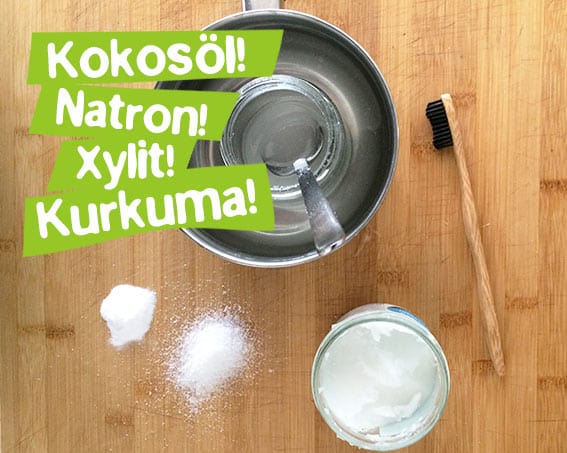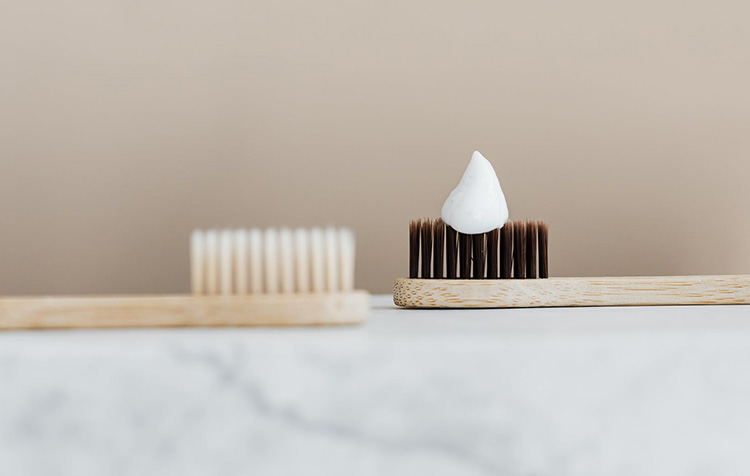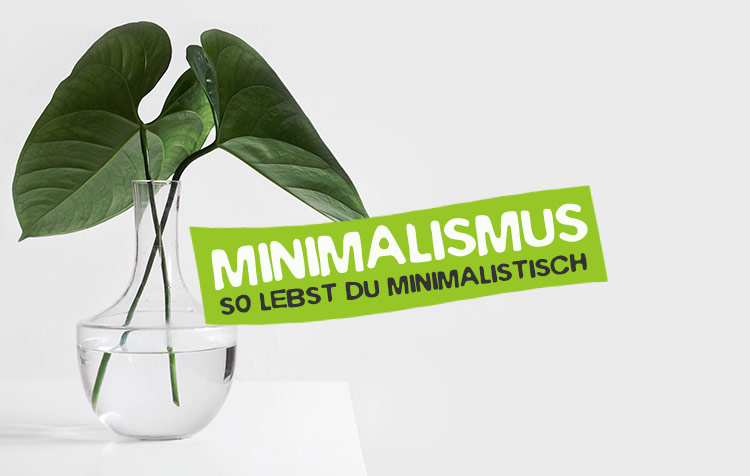It's nice to see your Make plastic free toothpaste yourself would like and just read this blog post. Because if you make your own toothpaste, you can compose it from natural ingredients, like coconut oil or xylitol (birch sugar). After all, it is not advised without reason not to swallow conventional toothpaste.
Homemade toothpaste or toothpaste is also the perfect plastic-free alternative to conventional toothpaste from the tube. Find out why your homemade toothpaste is even doubly plastic-free, how you can recognize plastic in toothpaste and how you can easily make your own toothpaste in this blog post. Let's go!
Here is another short Table of contents for this contribution:
- Why make plastic-free toothpaste yourself?
- Make your own toothpaste? Here's how!
- The perfect ingredients for homemade toothpaste
- Make your own toothpaste - The basic recipe
- Toothpaste + Toothbrush - My Best Care Tips
Why make plastic-free toothpaste yourself?
Conventional toothpaste from the supermarket is, depending on the ingredients, more dangerous for your health than you might think at first. That's because the toothpastes we don't make ourselves consist of many artificial additives for stretching and numerous sweeteners to make the toothpaste taste good to the masses. However, the toothpaste should not be swallowed, they say. This is a clear indication that the manufacturer is aware of the partly health-endangering composition of the toothpaste.
The use of conventional toothpaste is therefore particularly alarming for children. Children can easily swallow a lot of toothpaste. To avoid serious health consequences, you should therefore make your own toothpaste. The following are some of the dangerous ingredients of conventional toothpaste from plastic tubes:
Aspartame in toothpaste
Aspartame is a controversial sweetener that is found not only in toothpaste, but also in many foods. When your body processes aspartame, it creates dangerous toxins that promote memory loss or even depression. People with
Metabolic diseases can suffer particularly from the consequences of this substance. You can tell whether your toothpaste contains the active ingredient aspartame by the ingredient "phenylalanine". This is one of the basic components of aspartame, which is found in many toothpastes.
The sweetener is mixed into the toothpaste only for better taste. There are healthier natural substances to change the taste. Stevia and xylitol (birch sugar), for example. One more reason to make your own toothpaste and use natural ingredients for the production.
Microplastics are in toothpaste
Microplastics are small plastic beads that you find in almost every toothpaste from the supermarket. They are supposed to artificially thicken the toothpaste. Besides toothpaste, microplastics are also found in many other cosmetics. But microplastics have no place in toothpaste, or in our bathrooms in general. Microplastics pass into your body cells and remain there. But microplastics don't just harm your body: the little plastic balls are so small that neither the drain nor the sewage treatment plants can prevent them from entering our waters. So every day that you brush your teeth with toothpaste, ideally three times, more plastic enters the oceans. Fish take it for food, and it passes into the cells of the animals before the fish ends up on our plates again.
Microplastics have no place in toothpaste or other cosmetics! In addition to the microplastic in the ingredients, the packaging of the toothpaste is also made of plastic. Therefore, simply make your own toothpaste and you do without plastic in a double sense.
Fluorides in toothpaste
Today, there is still some disagreement about the effect of fluoride. Fluoride is a toxic substance, but it also hardens and stabilizes the tooth enamel. Who has caries problems, gets with the fluoride therefore support. However, those who do not have to struggle with caries should do without the fluoride in toothpaste. This is because fluoride is very sensitive to acid and ensures, for example, that minerals are broken down through the absorption of lactic acid. This makes the development of caries more likely.
In principle, therefore, fluorides in toothpaste should be avoided. Especially toothpaste for children should be given a wide berth, as children quickly swallow the toothpaste.
Triclosan in toothpaste

Triclosan destroys bacteria, but also your healthy oral flora, which is actually there to protect your body from dangerous foreign substances. Therefore, you must use a toothpaste without triclosan. The active ingredient is suspected of being carcinogenic. Perhaps this fact alone will prevent you from using a toothpaste with triclosan: The active ingredient is also found in dishwashing detergents and deodorants. In America, triclosan is banned - in our country, triclosan is found not only in toothpaste, but also in many other cosmetics and dishwashing detergents. If you want to live healthily, give the active ingredient a wide berth and simply make your own toothpaste.
These are just a few of the ingredients in conventional toothpaste that you probably used to brush your teeth with every day. To avoid these harmful ingredients in toothpaste, you should make your own toothpaste and make it from natural ingredients. The homemade toothpaste is the ideal plastic-free alternative, because you can be 100% sure that there are only the ingredients in the toothpaste that are also good for you and your health. It is a nice feeling to brush your teeth with a harmless toothpaste that you have made yourself.
Ingredients - How to make your own plastic-free toothpaste
Making your own toothpaste is really uncomplicated. You have a free choice of ingredients for your own toothpaste. First, you should think about what properties should be your toothpaste. Then you can choose the right ingredients and make your own toothpaste. The following properties should have a homemade toothpaste:
- Your toothpaste gently cleans the teeth
- The homemade toothpaste also cares for your gums
- The toothpaste prevents inflammation and tooth decay
- The toothpaste from own production has a good taste
- Your homemade toothpaste consists purely of natural ingredients
- The toothpaste is uncomplicated & can be made regularly
And it is precisely according to these properties that we now select the perfect ingredients for our own toothpaste.
Make your own toothpaste - The perfect ingredients
We do not want to have aspartame, fluoride, triclosan and certainly no microplastics in our homemade toothpaste. That is why we choose only natural ingredients to make the toothpaste ourselves. The following ingredients provide the perfect foundation, for a hygienic and great tasting toothpaste:
1. coconut oil for healthy white teeth
The fact that coconut oil optimally cleans and protects teeth makes it really easy for us to choose this ingredient for toothpaste. Choose a virgin and cold-pressed coconut oil, because then you can be sure that the coconut oil is also natural. This way, valuable minerals and vitamins remain in the coconut oil. Caprylic acid and lauric acid in coconut oil reduce the risk of tooth decay. The coconut oil has an antibacterial effect and that without any artificial additives. The coconut oil alone has a cleansing effect for your teeth and is for example also a recommendable Wisdom tooth surgery home remedy.
You can simply put a tablespoon of coconut oil in your mouth and let it work. Because the coconut oil has the property to bind harmful substances and makes the teeth white. Therefore, you should not swallow our homemade toothpaste, because this way the bound bacteria do not enter your body in the first place. With coconut oil or coconut fat you can also do the so-called oil pulling. I use in any case this coconut oil*, because it is native and cold-pressed, comes from a well-known manufacturer and is also still available in the plastic-free and reusable preserving jar.
2. sodium bicarbonate to bind pollutants
Baking soda cleans teeth and, like coconut oil, binds pollutants in the mouth. Just use a bit of baking soda powder to make your own plastic-free toothpaste. Baking soda is a time-honored home remedy for white teeth and can also be used beautifully as a mouth rinse. In addition to making your own toothpaste, baking soda is also useful for making many other cosmetics, such as your own deodorant, perfectly suitable. I use this sodium bicarbonate powder, to make my own toothpaste, because it is available in the plastic-free packaging and really cheap.
3. xylitol (birch sugar) for a good taste.
As you learned today, there are many sweeteners in our toothpaste to give us a good taste experience. But these substances, such as aspartame, are anything but healthy. The perfect natural alternative is therefore xylitol, so-called birch sugar. Xylitol is the perfect sugar substitute that provides no basis for caries-causing bacteria and protects your teeth from cavities, tartar and plaque. Birch sugar also reduces bad breath.
The unrefined sugar has exactly the opposite effect to the conventional refined sugar and is also perfect for your meals. I use this birch sugar, to be able to make my own toothpaste. Because xylitol is the perfect complement to the other ingredients of homemade toothpaste.
4. stevia as sweetener substitute
Just like xylitol, you can also use the natural effect of the stevia plant for your homemade toothpaste. Stevia is actually 300 times sweeter than sugar, but the plant has significantly fewer calories. The plant's natural active ingredient also has an antibacterial effect and is ideal as an ingredient for our homemade toothpaste. Stevia helps to treat bleeding gums, inflammation, tooth decay or even plaque naturally. Like xylitol, stevia prevents bacteria from growing, while conventional sugar promotes the formation of bacteria. So stevia and xylitol are the optimal "sweeteners" to make your own toothpaste. I have this stevia powder as the optimal ingredient for my toothpaste.
5. turmeric powder for white teeth
The Indian medicinal plant turmeric is another perfect ingredient to make your own healthy toothpaste. Even though the yellow dye is very intense (should not come into contact with clothing), turmeric makes your teeth really nice and white. The plant improves your oral environment and can even relieve swelling.
Those who, like me, still have mercury fillings, benefit even more from the cleansing effects of the turmeric plant: it helps to expel mercury and protects against the toxicity of the metal. I advise you to this turmeric powder, as it is available in the plastic-free packaging and quite cheap.
ATTENTION: Those who have defective tooth enamel should avoid turmeric or try it cautiously, because the teeth could become yellowish according to a testimonial. The same applies to plastic parts in the teeth - these can turn yellow.
6. oils for your desired taste
Since tastes are known to vary, you can change the flavor with the help of natural oils. For example, add a few drops of peppermint oil to make your perfect toothpaste. For this I recommend this peppermint oil* that you can use, of course, not only to make your own toothpaste, but for aromatherapy or basically in your medicine cabinet.
Alternatively, of course, go fennel oil, lemon oil and many other combinations.
Make your own toothpaste - recipe as a basis
The individual ingredients are already healthy for your teeth, but the combination to make your own toothpaste is absolutely ideal. Now you have to find the right mixing ratio. For this I give you this basic recipe to hand:
- 4-5 tablespoons coconut oil / coconut fat (order plastic free here now*)
- 2-3 tsp baking soda (order plastic free here now*)
- 1 pinch xylitol (birch sugar) / Alternatively 1 pinch stevia powder (order xylitol here* / order stevia powder here*)
- 1 pinch turmeric powder (order plastic free here now*)
- Optional: Depending on the desired taste 1 tsp oil (example: peppermint oil)
The coconut fat must be melted (put the glass in hot water). The coconut fat will always harden, so you must always stir well. Combine all the ingredients in the mentioned amounts and stir well. You can expand this toothpaste recipe with other natural ingredients. For example, myrrh extract, traganth or activated charcoal powder can be used as additional ingredients.
Toothpaste + Toothbrush - My Best Care Tips
That you can now make your own toothpaste is cool. So that you do not have to make your toothpaste every day anew and your teeth stay nice and clean and white, I have a few care tips for you:
- Store homemade toothpaste at room temperature (this keeps the toothpaste nice and soft).
- Apply the homemade toothpaste with a spoon on the toothbrush
- Use this wooden toothbrush with natural bristles from charcoal, which are biodegradable
- Change your toothbrush every 3-4 months (this is really important because the bristles on toothbrushes dull very quickly and no longer clean optimally).
- Keep making your own toothpaste! It can not be healthier and you do not produce plastic waste every 2-3 months!
I really hope that my tips and instructions on how to make your own toothpaste will help you a lot. ? It is really super easy and the ingredients you can also use for many other things. It's just a good feeling to be able to make your own toothpaste. If the toothpaste then also tastes good, you have saved money and waste. Now have fun with your homemade toothpaste and wooden toothbrush!
Stay clean,

PS.: Do you know why you absolutely need to brush your teeth with a Wooden toothbrush should use? Learn here, Why a wooden toothbrush is healthy in two senses. You will also learn in the Do It Yourself Blog for example, how to make your own Make deodorant yourself simply by following your heart.






Hi Christoph,
how do you do it with the toothpaste in these hot temperatures? If I keep them in the bathroom, I have only liquid toothpaste, because the coconut oil does not solidify. If I have them overnight in the refrigerator, I have in the morning rock hard toothpaste, which is also not suitable for brushing ... I would be grateful for a tip!
Love greetings
Melike
Hi Melike! Ich habe sie bei den Temperaturen auch im Kühlschrank. Morgens dann einfach mit einem Löffel auskratzen. Die Zahnpasta löst sich ja im Mund sofort auf. Alternativ erst einmal aus dem Kühlschrank stellen, in Ruhe Frühstücken und dann die etwas weichere Zahnpasta nutzen 😉
Stay clean,
Christoph
Hello
Meiner Zahnpasta ist es momentan zu warm 🙁
The melting point of coconut oil is 25 degrees Celsius.
Is it ok if it is in the refrigerator???
Love greetings
Hallo Kolla! Na klar, einfach vorher noch einmal verrühren und dann die Zahnpasta in den Kühlschrank stellen 🙂
Stay clean,
Christoph
Great recipe! I use coconut oil a lot in the bathroom - but I couldn't handle it with toothpaste. Somehow everything was greasy, especially since I like to use cold water in the summer. At another supplier, I found a tooth powder whose ingredients inspired me: instead of coconut oil, it had Rügen chalk in it. You can order it on the Internet - it arrived to me packed in paper bags. I now get along very well with the healing chalk instead of coconut oil. And a tip for those who try it new: do not take too much sodium bicarbonate. Possibly dilute a little more.
And another idea, if it must go fast: I use city turmeric Christmas spice (since I had once expired and just tried it for brushing my teeth) or ground cinnamon and cloves. Approximately in the ratio 3-4 times as much cinnamon as cloves.
The idea came from a book of recipes of natural cosmetics.
By the way: am grateful that there are like-minded people here. In my environment I'm rather seen as exotic experimental...
Hi Herdis! Auch cool! Ich probiere deine Variante auch Mal aus, kannte ich noch nicht 🙂
Stay clean,
Christoph
Comments are closed.